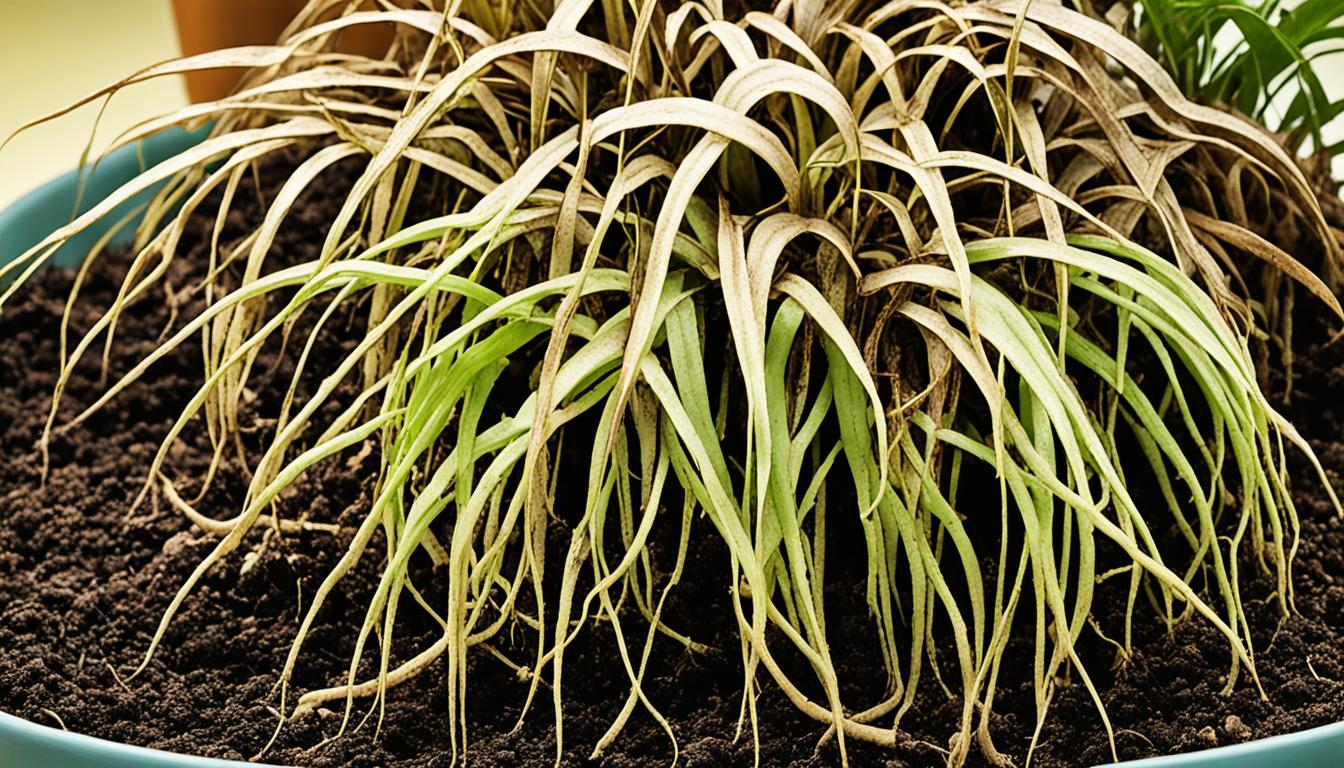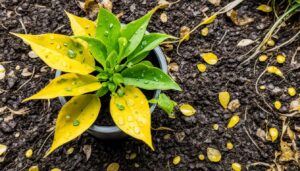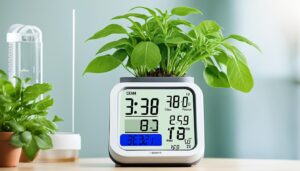Ever wondered why your indoor plants are wilting, turning yellow, or not growing? It could be root rot, a silent killer under the soil. But what is root rot, and how can you spot and fix it before it’s too late?
As a plant parent, knowing the signs and causes of root rot is key. Catching it early can save your plants and keep them healthy and bright. Are you ready to learn how to spot and treat this common issue?
Understanding Root Rot
Root rot is a common issue that can harm your indoor plants. It happens when plants get too much water, have poor drainage, and are attacked by fungi in the soil. Knowing about this problem is key to treating and preventing it.
What is Root Rot?
Root rot makes a plant’s roots decay and die. It’s often caused by overwatering and harmful soil fungi like Fusarium and Pythium. When roots don’t get enough oxygen because of too much moisture, they weaken and can get infected by fungi.
These fungi then eat away at the dying roots, making the problem worse. This can quickly spread through a plant and kill it if not caught early.
It’s important to spot the signs of root rot early to save your plants.
| Cause | Effect |
|---|---|
| Overwatering | Oxygen deprivation in plant roots |
| Soil-borne fungi (Fusarium, Pythium) | Feeding on dying root tissues, further exacerbating the problem |
“Root rot is a serious plant disease that can quickly lead to the demise of your indoor plants if left untreated.”
Identifying Signs of root rot indoor plants
Spotting early signs of root rot is key to saving your indoor plants. Look for wilting plants even when the soil seems wet. Yellowing or dropping leaves also hint at root trouble, as the roots can’t supply enough nutrients and water.
Stunted growth is another sign of root rot. If your plants aren’t growing well, their roots might be suffering. A foul, rotten odor from the soil means anaerobic conditions have set in, harming the roots.
Closer Inspection of the Roots
To really know if you have root rot, check the roots by removing the plant from its pot. Healthy roots are firm and white or cream-colored. But if they’re dark brown or black, mushy, and smell bad, they’re likely affected by rot.
“If you suspect root rot, it’s crucial to act quickly to save your plants. The sooner you can address the issue, the better chance you have of restoring your plants to full health.”
Keep an eye on your indoor plants’ roots to catch root rot early. This way, you can treat and prevent this harmful issue before it gets worse.
Treating and Preventing Root Rot
If you’ve found root rot in your indoor plants, act fast to save them. Sometimes, you might need to take big steps. But, there are ways to treat and prevent this issue.
Prevention Tips
Stopping root rot before it starts is the best approach. Here are some tips to keep your plants’ roots healthy:
- Use well-draining potting mix to ensure excess moisture doesn’t accumulate around the roots.
- Choose a container with adequate drainage holes to allow water to flow freely out of the soil.
- Establish a consistent watering schedule, watering only when the top inch or two of soil is dry.
- Provide your plants with the right amount of sunlight, as too much or too little can contribute to root rot.
- Regularly check the roots and repot plants as they outgrow their containers to prevent overcrowding.
By following these tips, you can help keep your indoor plants healthy and lower the risk of root rot.
| Action | Benefit |
|---|---|
| Use well-draining potting mix | Prevents excess moisture accumulation around roots |
| Choose a container with drainage holes | Allows excess water to flow out of the soil |
| Establish a consistent watering schedule | Avoids overwatering, a leading cause of root rot |
| Provide the right amount of sunlight | Ensures plants don’t become stressed and susceptible to root rot |
| Regularly repot plants | Prevents overcrowding and maintains healthy root systems |
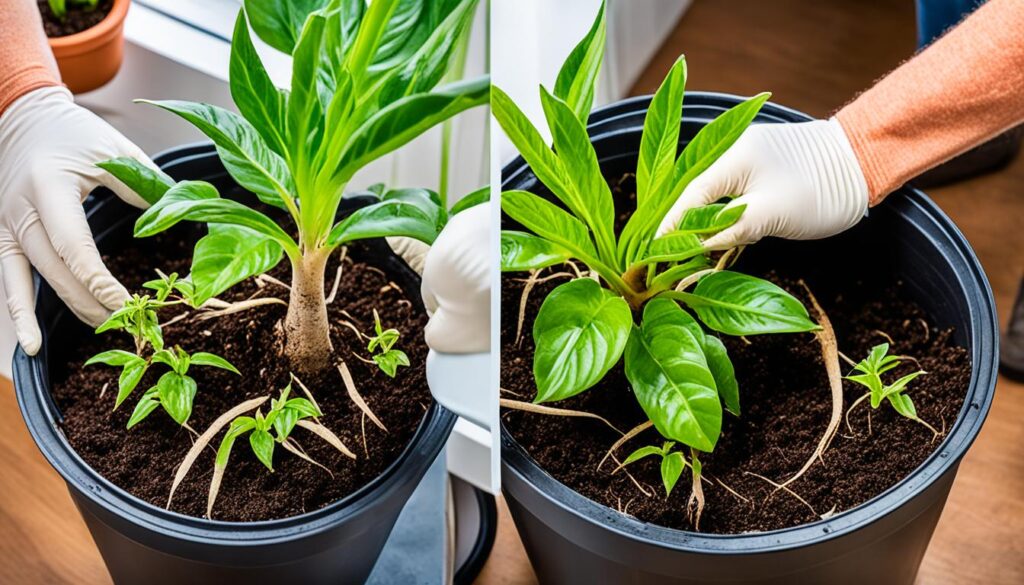
By preventing root rot, you can keep your indoor plants healthy and enjoy their beauty for years.
Causes and Risk Factors for root rot indoor plants
Root rot in indoor plants is often caused by overwatering and poor drainage. When soil stays too moist, it cuts off oxygen to the roots. This lets harmful fungi grow and cause root rot.
Some soil types, like heavy clay, have trouble draining well. This can lead to root rot. Also, plants like succulents and cacti don’t like wet soil. They’re more likely to get root rot if they’re watered too much.
Lack of inadequate sunlight can also be a problem. It keeps the soil wet, perfect for root rot to start.
| Cause | Description |
|---|---|
| Overwatering | Too much moisture in the soil stops the roots from getting oxygen. This lets harmful fungi grow. |
| Poor Drainage | Soil types like heavy clay can’t drain well. This leads to waterlogged soil. |
| Soil Type | Plants that like dry soil, like succulents and cacti, get root rot if watered too much. |
| Inadequate Sunlight | Not enough sunlight keeps the soil wet for too long. This is perfect for root rot. |
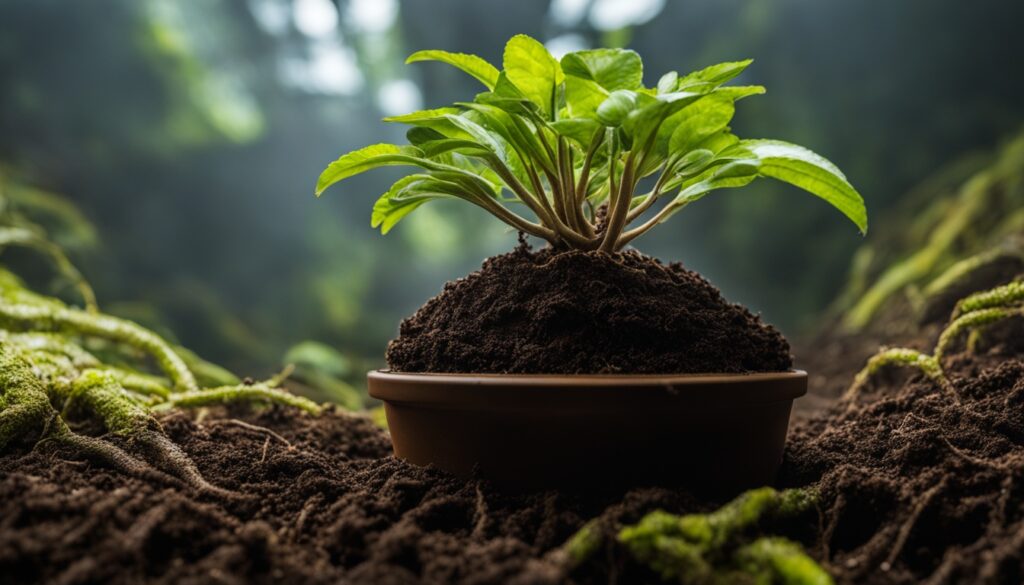
“Proper watering and drainage are essential for maintaining healthy roots and preventing the onset of root rot in indoor plants.”
Knowing the main causes and risk factors for root rot helps you protect your indoor plants. This way, you can keep them healthy and thriving.
Conclusion
Root rot is a big problem for indoor plants but can be prevented and treated. By knowing the causes, symptoms, and risk factors, you can keep your plants healthy. Proper watering, drainage, and repotting are key.
With careful attention and an eye on your plants, you can prevent root rot. By focusing on root rot prevention, your indoor plants will stay lush and healthy houseplants. The right indoor plant care helps your garden flourish, making your home more beautiful and lively.
By acting early to stop root rot, you protect your plants and keep your indoor space beautiful. With some knowledge and effort, you can have a thriving, easy-to-maintain indoor garden. This garden will give you joy and satisfaction.
FAQ
What is root rot?
Root rot is a disease that makes roots decay. It happens when roots stay wet for too long. This can be from too much water or harmful fungi in the soil.
What are the symptoms of root rot?
Signs of root rot include wilting leaves, yellowing or dropping leaves, and stunted growth. The soil may also smell bad. The only way to know for sure is to check the roots. Healthy roots are firm and white, while rotten roots are soft and brown or black.
How can I treat root rot?
To treat root rot, remove the affected parts of the plant and put it in fresh soil. Fix the issue of overwatering or fungal infection. If you catch it early, you might save the plant. But if the rot is too far gone, the plant might not survive.
How can I prevent root rot in my indoor plants?
Prevent root rot by knowing how much water your plant needs. Use potting mix that drains well and make sure your pot has good drainage. Don’t overwater. Check the roots often and move your plants to bigger pots when they need it to keep their roots healthy.
What are the primary causes of root rot in indoor plants?
Overwatering and poor drainage are the main causes of root rot. Wet soil cuts off oxygen to the roots, letting fungi take over. Some soils, not enough sunlight, and plants that like dry soil can also lead to root rot.


